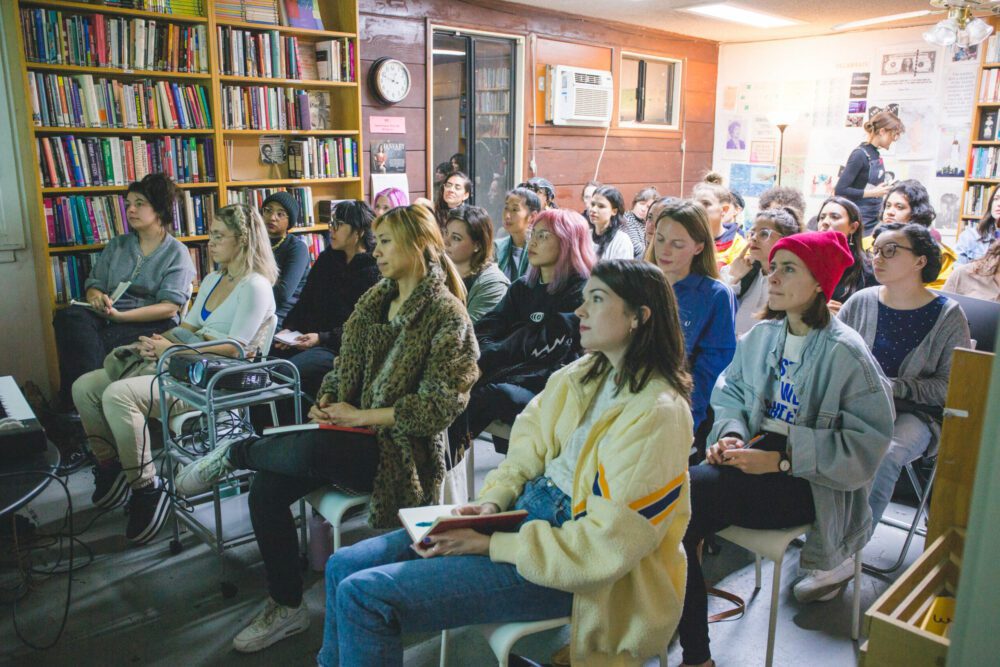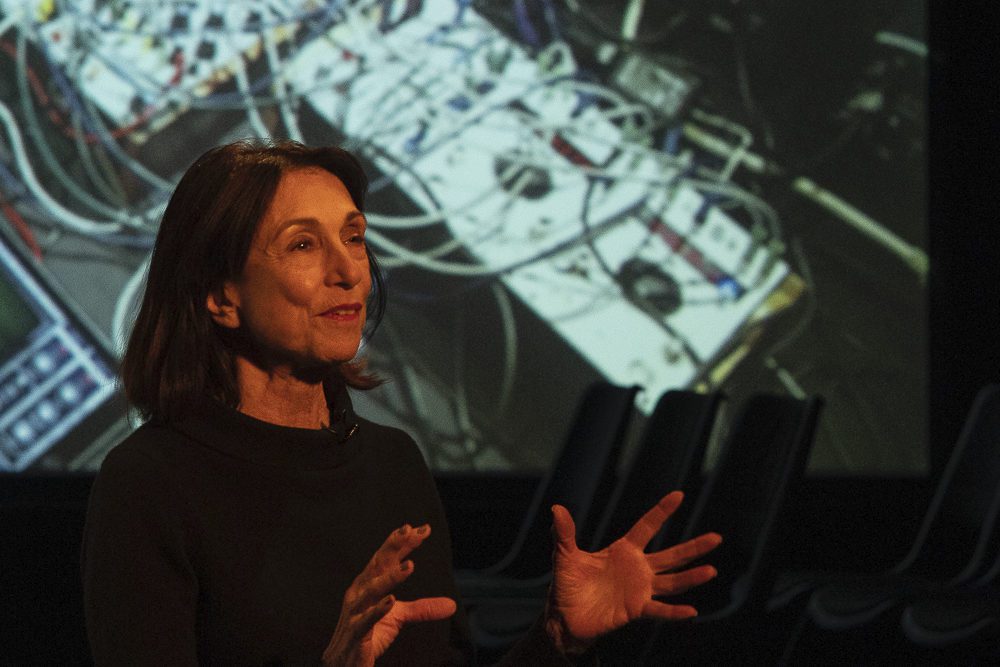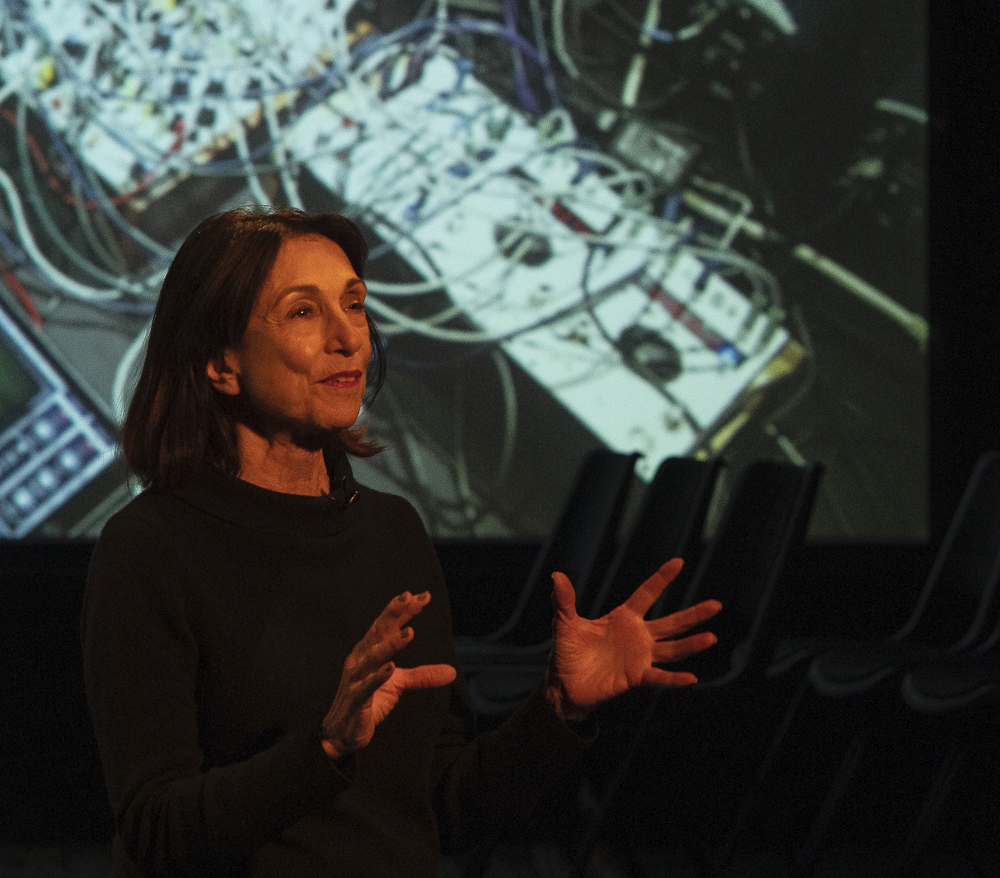

Have you ever wanted to borrow a synthesizer for a few weeks, just to see if it’s the right one for you? In Los Angeles, FeM Synth Lab offers just that, with a focus on making otherwise prohibitively expensive synths available to people of marginalized genders.
Three years ago, Natalie Robehmed founded FeM Synth Lab with two people she met through Women’s Center for Creative Work. The new group held their first workshop in 2017. From there, the project expanded to monthly meet-ups where people of various skill levels could learn new techniques and familiarize themselves with various gear.
Sabrina Ketel, who had been teaching herself Ableton, saw a notice of that first event on Facebook. “Everybody’s just really willing to help each other learn or help each other experiment and just share what they know,” she says of her first impressions of the group. A little over a year ago, Ketel came on board to help Robehmed run the group.
A synthesizer lending library is something that had been on their minds for a while. While the COVID-19 pandemic forced many to put ideas on hold, it actually pushed FeM Synth Lab to make theirs a reality. After a few years of in-person workshops, FeM Synth Lab wanted to provide a useful, hands-on experience for people at a time when they couldn’t get together in person. They also had some gear available to make that happen.
“We had access to some instruments that were just sitting there,” says Robehmed. The project came together in collaboration with Felisha Ledesma, who founded the program Resource Residency and helped launch Portland’s Synth Library.
Though people may have had more time on their hands to work on creative projects this year, the multitude of financial blows that Americans have endured also makes music equipment potentially more inaccessible. “Our aim is 100% to make it affordable and accessible to learn how to produce electronic music by giving access to all these instruments,” says Robehmed. They ask for a deposit when you check out a piece of equipment – anything from $1 to $20 – but you get it back when you return your piece (there’s an option to donate the deposit, but that’s completely up to the user).
Robehmed and Ketel are the only two people running the library, so it’s open one week out of the month. They typically open for orders on a Monday and the first two days are the BIPOC Priority Restock. Everyone else places reservations beginning on Wednesday of that week. “Our aim is to bring more people into electronic music, and into music production, who aren’t white, cis, and male,” says Robehmed. The BIPOC priority window for orders is part of the mission and Robehmed says that it has worked well. The following Sunday, everyone can check out the gear that they’ve reserved at Women’s Center for Creative Work’s office in Highland Park in a pandemic-safe way. All of the equipment is sanitized as well. “I spend most of the drop off days sanitizing gear,” says Ketel.
In the few months since it opened, FeM Synth Lab’s lending library has already gained a following. Farre Nixon has checked out multiple synths from the library. She’s a longtime fan of electronic music had been wanting to experiment with synths and production for a while. “I had no idea where to start,” she says. Then she started pricing synths. “It’s just so insanely prohibitive,” says Nixon, an architect who finished school last year.
Nixon moved to Los Angeles in early March and found out about FeM Synth Lab through a friend. When the library opened, she checked out the Moog DFAM (Drummer from Another Mother). A couple other Moogs, a Make Noise piece and a Korg followed. “It’s amazing because you can actually really feel the difference between each of these machines,” she says.
Now that she has tried out a few different synths, Nixon has an idea of what she will want to buy for herself in the future. “That’s given me a ton of direction,” she says. “I feel like now I’m able to turn a dream into a small, growing reality.” Plus, through the FeM Synth Lab, she’s gotten to know other people in her new city. “I’m building community,” she says, “and I feel like that’s the most important thing.”
A lot of the synths FeM Synth Lab has on hand were donated by musicians, mostly people in the Los Angeles area. Resource Residency donated a few Moogs. They’ve also worked with a couple different companies, notably Make Noise and 4MS, who have donated to FeM Synth Lab. You can even check out modular synths as well. “They’re the final frontier of inaccessibility,” says Robehmed. Through the partnership with 4MS, they have two rows of modules for users to play with. “That’s an amazing, beginner way to learn, or a great place to start because you can just experiment and it’s not too daunting,” says Robehmed. “It’s not an entire wall.”
They have effects pedals, mixers and interfaces too, but Ketel notes that they want to beef up the inventory of accessories. “We’d love to get monitors up there,” she says, “Stuff that will help you set up your studio, because that’s also something that can be really expensive to do.” FeM Synth Lab does accept both monetary and gear donations. They’re also looking to building up enough of a stockpile in the library so that people can check out more than one item at a time.
Robehmed mentions that Women’s Center for Creative Work has a motto: We’re a process, not a product. “I think about that all the time,” she says, “especially with regards to this project. It’s not perfect. It’s going to be iterative. We’re going to learn and grow and add.” For now, FeM Synth Lab remains open during that process, allowing future synth whizzes to grow alongside its expanding Lending Library.
Follow FeM Synth Lab on Instagram for ongoing updates.



